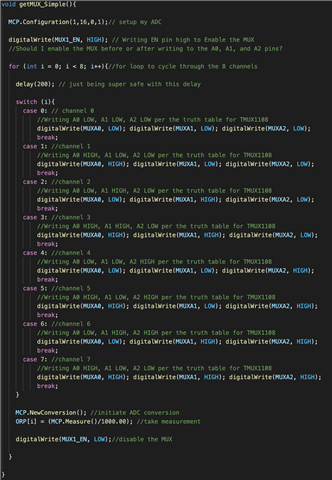Hello,
I am having issues with my TMUX1108.
Setup:
There are two TMUX1108's on my Arduino-type board, both sharing the A0, A1, and A2 pins, but with different EN pins.
Right now I am testing them with AA batteries (1.5v) ran to an ADC.
Problem:
The problem is, even when I have my AA input only going through one channel, I am getting the same reading on all channels.
So I am experiencing my 1.5v signal on all of the channels, even on the other TMUX1108 when its enable pin is low.
However, if I read just a single channel, I will get the correct value on that channel and 0.0v on the other channels.
So it has something to do with calling all the channels.
I am pretty sure that I am not calling the address pins correctly, so I am in search of some C/C++ sample code.
Here is a snippet of the code I am currently running with no success, but I've also included a screenshot thats easier to follow.
void setup(){
Serial.begin(9600);
pinMode(MUXA0, INPUT_PULLDOWN);
pinMode(MUXA1, INPUT_PULLDOWN);
pinMode(MUXA2, INPUT_PULLDOWN);
pinMode(MUX1_EN, INPUT_PULLDOWN);
digitalWrite(MUX1_EN, LOW);
}
void getMUX_Simple(){
MCP.Configuration(1,16,0,1);// setup my ADC
digitalWrite(MUX1_EN, HIGH); // Writing EN pin high to Enable the MUX
//Should I enable the MUX before or after writing to the A0, A1, and A2 pins?
for (int i = 0; i < 8; i++){//for loop to cycle through the 8 channels
delay(200); // just being super safe with this delay
switch (i){
case 0: // channel 0
//Writing A0 LOW, A1 LOW, A2 LOW per the truth table for TMUX1108
digitalWrite(MUXA0, LOW); digitalWrite(MUXA1, LOW); digitalWrite(MUXA2, LOW);
break;
case 1: //channel 1
//Writing A0 HIGH, A1 LOW, A2 LOW per the truth table for TMUX1108
digitalWrite(MUXA0, HIGH); digitalWrite(MUXA1, LOW); digitalWrite(MUXA2, LOW);
break;
case 2: //channel 2
//Writing A0 LOW, A1 HIGH, A2 LOW per the truth table for TMUX1108
digitalWrite(MUXA0, LOW); digitalWrite(MUXA1, HIGH); digitalWrite(MUXA2, LOW);
break;
case 3: //channel 3
//Writing A0 HIGH, A1 HIGH, A2 LOW per the truth table for TMUX1108
digitalWrite(MUXA0, HIGH); digitalWrite(MUXA1, HIGH); digitalWrite(MUXA2, LOW);
break;
case 4: //channel 4
//Writing A0 LOW, A1 LOW, A2 HIGH per the truth table for TMUX1108
digitalWrite(MUXA0, LOW); digitalWrite(MUXA1, LOW); digitalWrite(MUXA2, HIGH);
break;
case 5: //channel 5
//Writing A0 HIGH, A1 LOW, A2 HIGH per the truth table for TMUX1108
digitalWrite(MUXA0, HIGH); digitalWrite(MUXA1, LOW); digitalWrite(MUXA2, HIGH);
break;
case 6: //channel 6
//Writing A0 LOW, A1 HIGH, A2 HIGH per the truth table for TMUX1108
digitalWrite(MUXA0, LOW); digitalWrite(MUXA1, HIGH); digitalWrite(MUXA2, HIGH);
break;
case 7: //channel 7
//Writing A0 HIGH, A1 LOW, A2 LOW per the truth table for TMUX1108
digitalWrite(MUXA0, HIGH); digitalWrite(MUXA1, HIGH); digitalWrite(MUXA2, HIGH);
break;
}
MCP.NewConversion(); //initiate ADC conversion
ORP[i] = (MCP.Measure()/1000.00); //take measurement
digitalWrite(MUX1_EN, LOW);//disable the MUX
}
}


